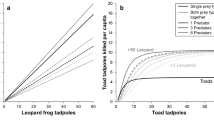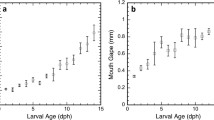Abstract
Clearance rates of adult Acanthocyclops vernalis Fisher and Leptodora kindti Focke on high and low helmeted juvenile Daphnia retrocurva Forbes were estimated in laboratory microcosms. For the Acanthocyclops experiment, clearance rates declined exponentially with increases in both prey carapace length and relative helmet length. For the Leptodora experiment, clearance rates declined exponentially only with increases in prey carapace length. Behavioral observations of 4th instar Chaoborus americanus Johannsen larvae feeding on mixtures of long and short featured adult D. retrocurva revealed no difference in evasion and escape efficiencies for the two morphs. Approximately 71% of each morph successfully evaded Chaoborus strikes and 24% escaped contact. These results suggest that, of the three predators, only Acanthocyclops is negatively influenced by the relative helmet length of D. retrocurva, at least with the size classes of prey studied in these experiments.
Similar content being viewed by others
References
Balcer, M. D., N. Korda & S. I. Dodson, 1984. A key and monograph of the Great Lakes crustacean zooplankton. University of Wisconsin Press, Madison, 175 pp.
Brandl, Z. & C. H. Fernando, 1978. Prey selection by the cyclopoid copepods Mesocyclops edax and Cyclops vicinus. Verh. int. Ver. Limnol. 20: 2505–2510.
Brooks, J. L., 1946. Cyclomorphosis in Daphnia. An analysis of D. retrocurva and D. galeata. Ecol. Monogr. 16: 409–477.
Brooks, J. L., 1957. The systematics of North American Daphnia. Mem. Conn. Acad. Arts Sci. 13: 1–180.
Brooks, J. L., 1959. Cladocera. In W. T. Edmondson (ed.), Freshwater Biology, 2nd Edn. Wiley-Interscience, N.Y.: 587–656.
Cooper, S. D., 1979. The impact of predation on cladoceran assemblages. Ph. D. Thesis, Univ. Wisconsin-Madison, 179 pp.
Cooper, S. D. & C. R. Goldman, 1980. Oppossum shrimp (Mysis relicta) predation on zooplankton. Can. J. Fish. aquat. Sci. 37: 909–919.
Cummins, K. W., R. R. Costra, R. E. Rowe, G. A. Moshiri, R. M. Scanlon & R. K. Zajdel, 1969. Ecological energetics of a natural population of the predaceous zooplankter Leptodora kindti Focke (Cladocera). Oikos 20: 189–223.
Dodson, S. I., 1974a. Adaptive change in plankton morphology in response to size-selective predation: A new hypothesis of cyclomorphosis. Limnol. Oceanogr. 19: 721–729.
Dodson, S. I., 1974b. Zooplankton competition and predation: an experimental test of the size efficiency hypothesis. Ecology 55: 605–613.
Dodson, S. I., 1975. Predation rates of zooplankton in arctic ponds. Limnol. Oceanogr. 20: 426–433.
Dodson, S. I., 1984. Predation of Heterocope septentrionalis on two species of Daphnia: Morphological defenses and their cost. Ecology 65: 1249–1257.
Gilbert, J. J., 1967. Asplanchna and postero-lateral spine production in Brachionus calyciflorus. Arch. Hydrobiol. 65: 1–62.
Grant, J. W. G. & I. A. E. Bayly, 1981. Predator induction of crests in morphs of the Daphnia carinata King complex. Limnol. Oceanogr. 26: 201–218.
Halbach, U., 1971. Zum Adaptivwert der zyklomorphen Dornenbildung von Brachionus calcyiflorus Pallas (Rotatoria). Oecologia (Berl.) 6: 267–288.
Hall, D. J., 1964. An experimental approach to the dynamics of a natural population of Daphnia galeata mendotae. Ecology 45: 94–112.
Havel, J. E. & S. I. Dodson, 1984. Chaoborus predation on typical and spined morphs of Daphnia pulex: Behavioral observations. Limnol. Oceanogr. 29: 487–494.
Havel, J. E. & S. I. Dodson, 1985. Environmental cues of cyclomorphosis in Daphnia retrocurva. Freshwat. Biol. (in press).
Herbert, P. D. N. & J. M. Loaring, 1980. Selective predation and the species composition of arctic ponds. Can. J. Zool. 58: 422–426.
Kerfoot, W. C., 1975. The divergence of adjacent populations. Ecology 56: 1298–1313.
Kerfoot, W. C., 1977. Implications of copepod predation. Limnol. Oceanogr. 22: 316–325.
Lane, P. A., 1978. Role of invertebrate predation in structuring zooplankton communities. Verh. int. Ver. Limnol. 20: 480–485.
Mordukhai-Boltovskaia, E. D., 1958. Preliminary notes on the feeding of the carnivorous cladocerans Leptodora kindti and Bythotrepes. Dokl. Akad. Nauk. Biol. Sci. Sect. 222: 828–830.
Murphy, J. S., 1970. A general method for the monoxenic cultivation of the Daphnidae. Biol. Bull. 139: 321–332.
Neter, J. & W. Wasserman, 1974. Applied linear statistical models. Richard D. Irwin, Inc., Homewood, Ill., 842 pp.
O'Brien, W. J. & G. L. Vinyard, 1978. Polymorphism and predation: the effect of invertebrate predation on the distribution of two varieties of Daphnia carinata in South India ponds. Limnol. Oceanogr. 23: 452–460.
O'Brien, W. J., D. Kettle & H. P. Riessen, 1979. Helmets and invisible armor: Structures reducing predation from tactile and visual planktivores. Ecology 60: 287–294.
Pastorok, R. A., 1980. Selection of prey by Chaoborus larvae: a review and new evidence for behavioral flexibility. In W. C. Kerfoot (ed.) Ecology and evolution of zooplankton communities. University Press of New England, Hanover: 538–554.
Pastorok, R. A., 1981. Prey vulnerability and size selection by Chaoborus larvae. Ecology 62: 1311–1324.
Riessen, H. P., W. J. O'Brien & B. Loveless, 1984. An analysis of the components of Chaoborus predation on zooplankton. Ecology 65: 514–522.
Ryan, T. A., B. L. Joiner & B. F. Ryan, 1981. MINITAB reference manual. Duxbury Press, Boston, Mass., 147 pp.
Saether, O. A., 1972. Chaoboridae. Binnengewasser 26: 257–280.
Smith, K. & C. H. Fernando, 1978. A guide to the freshwater calanoid and cyclopoid copepod Crustacea of Ontario. Univ. Waterloo Biol. Set. 18, 74 pp.
Swift, M. C. & A. Y. Fedorenko, 1975. Some aspects of prey capture by Chaoborus larvae. Limnol. Oceanogr. 20: 418–425.
Wong, C. K., 1981. Cyclomorphosis in Bosmina and copepod predation. Can. J. Zool. 59: 2049–2052.
Wonnacott, T. H. & R. J. Wonnacott, 1977. Introductory statistics for business and economics. John Wiley & Sons, N.Y., 753 pp.
Author information
Authors and Affiliations
Rights and permissions
About this article
Cite this article
Havel, J.E. Predation of common invertebrate predators on long- and short-featured Daphnia retrocurva . Hydrobiologia 124, 141–149 (1985). https://doi.org/10.1007/BF00006796
Received:
Revised:
Accepted:
Issue Date:
DOI: https://doi.org/10.1007/BF00006796




